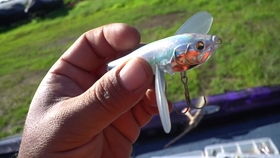Content:
Introduction: D钓鱼, an ancient and beloved pastime, has evolved into a sophisticated sport that requires a blend of patience, skill, and knowledge. One of the most crucial aspects of fishing is learning how to properly reel in a fish, a process known as "reeling." In this article, we will delve into the art of fish reeling and provide you with valuable tips and techniques, complemented by helpful video tutorials to enhance your fishing experience.

Understanding the Basics of Reeling: Before diving into the specifics of reeling techniques, it's essential to understand the basic principles. Reeling is the act of winding the line onto the reel while the fish is on the line, allowing you to control the fish and bring it closer to the boat or shore. The key to successful reeling lies in maintaining a balance between tension and slack, as well as using the right amount of force to prevent the fish from breaking the line.
Choose the Right Reel: The first step in mastering the art of reeling is selecting the appropriate reel for your fishing style and the type of fish you're targeting. There are various types of reels available, including spinning reels, baitcasting reels, and fly reels. Each reel has its unique features and is designed for specific fishing scenarios.
Learn the Basics of Line Management: Proper line management is crucial for successful reeling. Ensure that your line is free of twists and knots, as these can hinder your ability to reel in the fish effectively. Keep your line tight but not too tight, as excessive tension can cause the fish to become stressed or even break the line.
The Power of the Hand: The hand closest to the reel is responsible for applying pressure and controlling the line. This hand should be firm but not overly aggressive. The other hand, known as the "feeler" hand, is used to detect the fish's movements and provide feedback to the hand controlling the reel.
The Reeling Technique: There are several techniques for reeling in a fish, and the best one depends on the species and the size of the fish. Here are some common reeling techniques:
a. The Gentle Reel: This technique involves reeling in the line slowly and steadily, allowing the fish to tire itself out. It's ideal for smaller fish or when you want to reduce stress on the fish.
b. The Fast Reel: For larger fish or when you need to quickly bring the fish to the boat, the fast reel technique is effective. It involves reeling in the line quickly and with more force.
c. The Stop-and-Go Reel: This technique involves reeling in the line for a few seconds, then stopping to allow the fish to take a breath, and then continuing to reel. It's a great way to control the fish's movements and prevent it from breaking the line.
The Importance of Timing: Timing is everything when it comes to reeling. Pay attention to the fish's movements and be ready to adjust your technique accordingly. If the fish is making a strong run, you may need to apply more pressure to the line. Conversely, if the fish is struggling or tired, you may need to ease up on the pressure.
Video Tutorials for Enhanced Learning: To help you master the art of reeling, we have compiled a series of video tutorials that demonstrate various reeling techniques. These tutorials will provide you with step-by-step instructions and visual demonstrations, allowing you to practice and refine your skills.
Conclusion: Reeling is a skill that takes time to develop, but with practice and the right guidance, you can become a proficient fisherman. By understanding the basics of line management, choosing the right reel, and mastering different reeling techniques, you'll be well on your way to successfully bringing in your catch. Don't forget to supplement your learning with video tutorials to enhance your skills and become a true fishing aficionado. Happy fishing!












